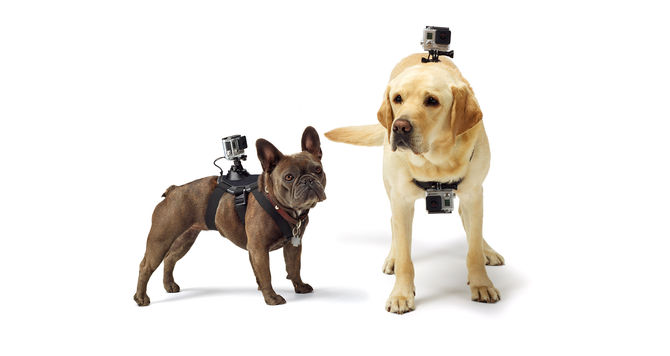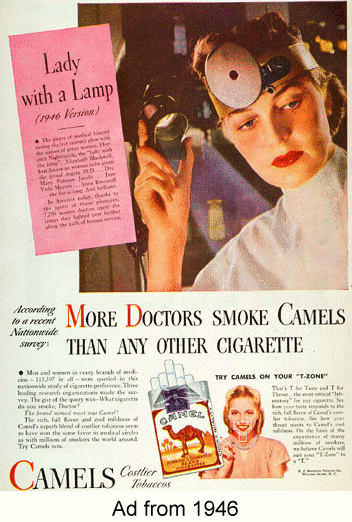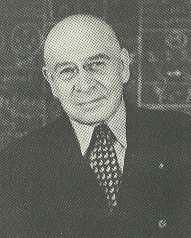
Monkey Business
On the heels of my recent comments re the now-famous public-domain macaque selfies and photographer David Slater’s futile efforts to establish copyright thereto, GoPro has announced a camera mount that you can strap onto your dog.
I’m no lawyer, but here’s my layman’s opinion: Presumably, if the legal owner of both the camera and the animal placed and activated the camera, the resulting images would be copyrightable; the pet would become something akin to an animated tripod or “dolly.” Also, the owner could plausibly claim a contractual relationship with his or her pet that included the performance of assorted tricks and services (fetching the newspaper, playing dead) in return for the benefits of room, board, and medical care — in effect, acting as a compensated full-time employee. The outcome of any such services would thus become, in terms of the copyright laws, the equivalent of work made for hire (WMFH).

GoPro Fetch harness
GoPro calls its canine harness the Fetch (MSRP $59.99). Compatible with all GoPro cameras, it offers both a chest-mount and a back-mount option. From the looks of it as shown online, you could use it as is on other dog-sized pets or, I suppose, change the straps to adapt it to any suitable domesticated or captive animal.
The cheapest GoPro costs $199, more than I’d care to risk strapped to some critter’s back. But Polaroid has recently introduced a smaller, cheaper camera that can do most of the same things (it lacks built-in wi-fi, which enables live streaming). That’s the water-resistant “lifestyle action camera” they’ve named the Polaroid Cube (MSRP $99.99; you can add a waterproof case for $24.99).

Kodak PixPro SP1 Action Cam
And Kodak offers its PIXPRO SP1 Action Cam for $199.99, with built-in wi-fi, and also 32ft./10m waterproof, 6.5ft./2m shockproof, dustproof, and freezeproof — making it definitely competitive with the GoPro, and less cumbersome. Coming soon: the Kodak PixPro SP360, which will provide a 360-degree view.
As always with digitech, this product type will get more powerful and feature-rich, less expensive, and smaller. At some point, these devices will become sufficiently miniaturized to enable implantation. So I envision a day in the near future when people will set up internet/intranet live-streaming of their pet’s eye views, and zoos will live-stream giraffe’s-eye, lion’s-eye, snake’s-eye views of their inhabitants’ experiences and adventures.
Another prediction: Not only will we implant these minicams in our pets, we’ll implant them in ourselves, becoming the walking equivalents of Garry Winogrand. See my post from earlier this summer, “Garry Winogrand: MonkeyCam Redux at the Met.”

Polaroid Cube
By the way, GoPro owes at least an acknowledgment and a vote of thanks to David Letterman and his staff, who premiered “Late Night Monkey Cam” — a small video camera attached to the back of Zippy, a tame chimpanzee who was then set loose to roam around the set — on his talk show in March 1986. Though this wasn’t the first time an animal carried an activated camera, the popularity of this feature on the internationally syndicated Letterman show certainly created a receptive environment for pet-friendly consumer-end video cams.
Indeed, taken in combination with Letterman’s “Stupid Pet Tricks” feature, we might find in this the genesis of I Can Has Cheeseburger? and the global cat video phenomenon.
•
 Gregory Eddi Jones has published a substantial exchange between us, “In Dialogue with A. D. Coleman,” at his blog, In the In-Between: journal of digital imaging artists, which he describes as “a web-based photography journal founded by photo-artist and writer Gregory Eddi Jones in June of 2012.”
Gregory Eddi Jones has published a substantial exchange between us, “In Dialogue with A. D. Coleman,” at his blog, In the In-Between: journal of digital imaging artists, which he describes as “a web-based photography journal founded by photo-artist and writer Gregory Eddi Jones in June of 2012.”
We developed this as a q&a via email, over a period of several months earlier this year. Greg’s questions proved intriguing, so I responded at some length. I commend the resulting back-and-forth to readers of this blog, especially those with a particular interest in issues of digital imaging, who will find Jones’s site a rich trove of material relevant to those concerns.
Doing the Math

Woman doctor smoking Camels, ad, 1946
Speaking of digital photography: According to the September 13, 2014 ABC-News story “Alluring Photographs of Smoke Plumes,” photographer Thomas Herbrich made his studies of cigarette smoke “using a high-speed flash with a flash duration of 1/10,000 second, and took more than 100,000 digital photos over the course of three months.”
“Only a few milliseconds pass between the recognition of the subject, and taking the shot,” the unsigned article reports. “Only 20 out of 100,000 photos made the final cut, as the moment the shutter released wasn’t at exactly the right millisecond, or because other interfering smoke elements were in the photo. To capture these photos,” it continues, “Herbrich attached a burning cigarette to a tripod in his studio with a black background. He had his brother hold the high-speed flash and manually focused his camera. The field of smoke is no bigger than 10 inches in diameter.”
“Herbrich said the problem is ‘When I see a nice smoke form, my eye has to tell my brain, may brain tells my thumb, and the thumb presses the button — the camera makes click-clack … and all this requires some milliseconds, which is a long time for catching smoke. It is really superfast.’ Herbrich has to wait for the air to be totally ‘quiet,’ meaning no motion as to disturb the smoke flow. This is why he is only able to shoot 15 to 20 cigarettes per day. He used 600 cigarettes in total.”

Chesterfield ad, Ronald Reagan, LIFE magazine, 1948
My calculations: 600 cigarettes = 30 packs. 100,000 exposures of 600 cigarettes = 166.6 exposures per coffin nail. It takes a regular cigarette, lit but unsmoked, somewhere between 10-15 minutes to burn on its own, from end to end (or filter). Let’s say the average is 12.5 minutes; Herbrich had to make 13 exposures a minute, which comes to one every 4.6 seconds. Hardly enough time to “manually focus” a digital camera again and again after Herbrich’s “recognition of the subject” and his eye talking to his brain which then talks to his thumb so the camera can make click-clack, yadayadayada. But certainly enough time for a pre-focused digital camera to take automatic exposures at pre-set intervals, the most-likely-case scenario here.
In short: Pleasantly decorative images, though the stats as indicated — a mere 20 successes out of 100,000 — rank with Garry Winogrand’s pathetic output in his final years as not worth the effort. But the backstory of Herbrich’s little project, as given, simply beggars belief. Another instance of the conventional art-school trope I’ve discussed at length in previous posts, I should add; 20 variants on the same image structure, with a single variable. (To view more from this series, visit Thomas Herbirch’s website.)
By the way, does making purely decorative images of a proven cancerous substance, designed for sale in the fine-art market, differ in some ethical way from using your status as a doctor or your silver-screen celebrity to hawk coffin nails for a hefty fee? Just asking.
Owning Yourself

Alfred Korzybski
Alfred Korzybski, founder of the discipline known as general semantics, argued that we should beware of all variants of the verb to be. In using it, he proposed, we risk falling prey to the fallacy he called “the is of identity” — the tendency to freeze the subject of that verb into a single aspect, when it (or he or she or they) will inevitably have multiple facets that “the is of identity” will ignore and dismiss.
Korzybski recommended instead that we consider our subjects as both variegated and mutable — that is, not just multifaceted but changeable — and adjust our discussion of them accordingly. So, instead of saying “John is a thief,” we’d say “John stole something today” or “John committed a theft today.” That names the infraction without binding our vision of John to a single act or behavior pattern, enables a more rounded view of John as a complex person, and allows for the possibility that this might represent a one-time act on his part or, even if he’s done it repeatedly, that he might not do so again.
I took Korzybski’s insight to heart when I came across it in the late 1980s. Though even a close reader of my work might not notice it, nor those who attend my lectures and classes, I’ve tried ever since to avoid employing “the is of identity” as much as possible. And I’d like to think that the recent tendency of people who’ve behaved badly to say “That’s not who I am” or some variant thereon indicates their awareness of and agreement with Korzybski’s idea, which I would consider sagacious and would give us something in common.
However, those uttering this now formulaic locution strike me as unlikely adherents of Korzybski. Alas, in their mouths it comes across mostly as a way of deflecting, avoiding, or even denying responsibility for one’s own actions — something akin to claiming multiple-personality disorder, alien possession, or “The devil made me do it.” For example:

This is not Ray Rice (ABC News screeenshot, Sept. 8, 2014
• Caught on two Atlantic City casino video cameras cold-cocking his fiancée in an elevator and dragging her into the hall, Baltimore Ravens running back Ray Rice — suddenly released by the Ravens and suspended by the NFL, with his now-wife and enabler Janay by his side — told the world at a press conference, “That’s not who I am as a man.”
• Caught on an audio recording making racist comments, Los Angeles Clippers owner Donald Sterling had the team’s press office issue the following statement to TMZ: “Mr. Sterling is emphatic that what is reflected on that recording is not consistent with, nor does it reflect his views, beliefs or feelings. It is the antithesis of who he is, what he believes and how he has lived his life. … He feels terrible that such sentiments are being attributed to him and apologizes to anyone who might have been hurt by them.”

This is not a pipe.
• Faulkner (Arkansas) County Circuit Judge Michael Maggio “admitted posting details from actress Charlize Theron’s closed-record adoption of a child in 2012 on tigerdroppings.com, a Louisiana State University fan site, using the online name ‘geauxjudge,’ according to documents that a judicial commission submitted to the state Supreme Court,” which ordered his immediate dismissal from the bench. Maggio said in a statement: “I take full responsibility for the comments that have been attributed to me. I apologize deeply for my lapse in personal judgment and for that, I have no excuse. The comments posted were not acceptable. These comments are not a reflection of who I am.”

Alfred Korzybski, “Science and Sanity” (1933), cover
• Caught on camera calling an obnoxious fan “faggot,” Chicago Bulls center Joakim Noah subsequently told ESPN interviewer Kevin Arnovitz (who is gay), “I’m disappointed because that’s not me. … It’s disappointing because I’m not like that. … I’m pissed off at myself because that’s not who I am.” Pressed by Arnovitz on the point that this could make it harder for an out gay ballplayer, Noah replied, “I know. And that’s not who I am.” (He comes by this rationalization honestly. His mother, Cecilia Rodhe, explained, “He chose the wrong word. He wanted to say, ‘Move away and stop harassing me,’ but he lost control and used that word.” A common mistake.)
Though it’s been quite awhile, I’ve written and published a few things I regret. However, that happened back in the days of print. And, among the things I cherish about print as a communication medium, irrevocability ranks very high indeed.
You see, with a few taps on my keyboard I can change anything I’ve published at my websites since 1995. And, short of tracking down the originally published version via the Wayback Machine, you’ll never know the difference. But what appears in print endures so long as one paper copy lasts.
I love that, because it keeps me honest. The habits I acquired as a writer publishing in print media have carried over to my writing online. So I want to assure my readers that whatever they read with my byline on it, in any medium, going all the way back to 1964 — I wrote and published that. That was me (pace Korzybski), at least at that time. I own it, warts and all.
Still More Ends and Odds
Monkey Business
On the heels of my recent comments re the now-famous public-domain macaque selfies and photographer David Slater’s futile efforts to establish copyright thereto, GoPro has announced a camera mount that you can strap onto your dog.
I’m no lawyer, but here’s my layman’s opinion: Presumably, if the legal owner of both the camera and the animal placed and activated the camera, the resulting images would be copyrightable; the pet would become something akin to an animated tripod or “dolly.” Also, the owner could plausibly claim a contractual relationship with his or her pet that included the performance of assorted tricks and services (fetching the newspaper, playing dead) in return for the benefits of room, board, and medical care — in effect, acting as a compensated full-time employee. The outcome of any such services would thus become, in terms of the copyright laws, the equivalent of work made for hire (WMFH).
GoPro Fetch harness
GoPro calls its canine harness the Fetch (MSRP $59.99). Compatible with all GoPro cameras, it offers both a chest-mount and a back-mount option. From the looks of it as shown online, you could use it as is on other dog-sized pets or, I suppose, change the straps to adapt it to any suitable domesticated or captive animal.
The cheapest GoPro costs $199, more than I’d care to risk strapped to some critter’s back. But Polaroid has recently introduced a smaller, cheaper camera that can do most of the same things (it lacks built-in wi-fi, which enables live streaming). That’s the water-resistant “lifestyle action camera” they’ve named the Polaroid Cube (MSRP $99.99; you can add a waterproof case for $24.99).
Kodak PixPro SP1 Action Cam
And Kodak offers its PIXPRO SP1 Action Cam for $199.99, with built-in wi-fi, and also 32ft./10m waterproof, 6.5ft./2m shockproof, dustproof, and freezeproof — making it definitely competitive with the GoPro, and less cumbersome. Coming soon: the Kodak PixPro SP360, which will provide a 360-degree view.
As always with digitech, this product type will get more powerful and feature-rich, less expensive, and smaller. At some point, these devices will become sufficiently miniaturized to enable implantation. So I envision a day in the near future when people will set up internet/intranet live-streaming of their pet’s eye views, and zoos will live-stream giraffe’s-eye, lion’s-eye, snake’s-eye views of their inhabitants’ experiences and adventures.
Another prediction: Not only will we implant these minicams in our pets, we’ll implant them in ourselves, becoming the walking equivalents of Garry Winogrand. See my post from earlier this summer, “Garry Winogrand: MonkeyCam Redux at the Met.”
Polaroid Cube
By the way, GoPro owes at least an acknowledgment and a vote of thanks to David Letterman and his staff, who premiered “Late Night Monkey Cam” — a small video camera attached to the back of Zippy, a tame chimpanzee who was then set loose to roam around the set — on his talk show in March 1986. Though this wasn’t the first time an animal carried an activated camera, the popularity of this feature on the internationally syndicated Letterman show certainly created a receptive environment for pet-friendly consumer-end video cams.
Indeed, taken in combination with Letterman’s “Stupid Pet Tricks” feature, we might find in this the genesis of I Can Has Cheeseburger? and the global cat video phenomenon.
•
We developed this as a q&a via email, over a period of several months earlier this year. Greg’s questions proved intriguing, so I responded at some length. I commend the resulting back-and-forth to readers of this blog, especially those with a particular interest in issues of digital imaging, who will find Jones’s site a rich trove of material relevant to those concerns.
Doing the Math
Woman doctor smoking Camels, ad, 1946
Speaking of digital photography: According to the September 13, 2014 ABC-News story “Alluring Photographs of Smoke Plumes,” photographer Thomas Herbrich made his studies of cigarette smoke “using a high-speed flash with a flash duration of 1/10,000 second, and took more than 100,000 digital photos over the course of three months.”
“Only a few milliseconds pass between the recognition of the subject, and taking the shot,” the unsigned article reports. “Only 20 out of 100,000 photos made the final cut, as the moment the shutter released wasn’t at exactly the right millisecond, or because other interfering smoke elements were in the photo. To capture these photos,” it continues, “Herbrich attached a burning cigarette to a tripod in his studio with a black background. He had his brother hold the high-speed flash and manually focused his camera. The field of smoke is no bigger than 10 inches in diameter.”
“Herbrich said the problem is ‘When I see a nice smoke form, my eye has to tell my brain, may brain tells my thumb, and the thumb presses the button — the camera makes click-clack … and all this requires some milliseconds, which is a long time for catching smoke. It is really superfast.’ Herbrich has to wait for the air to be totally ‘quiet,’ meaning no motion as to disturb the smoke flow. This is why he is only able to shoot 15 to 20 cigarettes per day. He used 600 cigarettes in total.”
Chesterfield ad, Ronald Reagan, LIFE magazine, 1948
My calculations: 600 cigarettes = 30 packs. 100,000 exposures of 600 cigarettes = 166.6 exposures per coffin nail. It takes a regular cigarette, lit but unsmoked, somewhere between 10-15 minutes to burn on its own, from end to end (or filter). Let’s say the average is 12.5 minutes; Herbrich had to make 13 exposures a minute, which comes to one every 4.6 seconds. Hardly enough time to “manually focus” a digital camera again and again after Herbrich’s “recognition of the subject” and his eye talking to his brain which then talks to his thumb so the camera can make click-clack, yadayadayada. But certainly enough time for a pre-focused digital camera to take automatic exposures at pre-set intervals, the most-likely-case scenario here.
In short: Pleasantly decorative images, though the stats as indicated — a mere 20 successes out of 100,000 — rank with Garry Winogrand’s pathetic output in his final years as not worth the effort. But the backstory of Herbrich’s little project, as given, simply beggars belief. Another instance of the conventional art-school trope I’ve discussed at length in previous posts, I should add; 20 variants on the same image structure, with a single variable. (To view more from this series, visit Thomas Herbirch’s website.)
By the way, does making purely decorative images of a proven cancerous substance, designed for sale in the fine-art market, differ in some ethical way from using your status as a doctor or your silver-screen celebrity to hawk coffin nails for a hefty fee? Just asking.
Owning Yourself
Alfred Korzybski
Alfred Korzybski, founder of the discipline known as general semantics, argued that we should beware of all variants of the verb to be. In using it, he proposed, we risk falling prey to the fallacy he called “the is of identity” — the tendency to freeze the subject of that verb into a single aspect, when it (or he or she or they) will inevitably have multiple facets that “the is of identity” will ignore and dismiss.
Korzybski recommended instead that we consider our subjects as both variegated and mutable — that is, not just multifaceted but changeable — and adjust our discussion of them accordingly. So, instead of saying “John is a thief,” we’d say “John stole something today” or “John committed a theft today.” That names the infraction without binding our vision of John to a single act or behavior pattern, enables a more rounded view of John as a complex person, and allows for the possibility that this might represent a one-time act on his part or, even if he’s done it repeatedly, that he might not do so again.
I took Korzybski’s insight to heart when I came across it in the late 1980s. Though even a close reader of my work might not notice it, nor those who attend my lectures and classes, I’ve tried ever since to avoid employing “the is of identity” as much as possible. And I’d like to think that the recent tendency of people who’ve behaved badly to say “That’s not who I am” or some variant thereon indicates their awareness of and agreement with Korzybski’s idea, which I would consider sagacious and would give us something in common.
However, those uttering this now formulaic locution strike me as unlikely adherents of Korzybski. Alas, in their mouths it comes across mostly as a way of deflecting, avoiding, or even denying responsibility for one’s own actions — something akin to claiming multiple-personality disorder, alien possession, or “The devil made me do it.” For example:
This is not Ray Rice (ABC News screeenshot, Sept. 8, 2014
• Caught on two Atlantic City casino video cameras cold-cocking his fiancée in an elevator and dragging her into the hall, Baltimore Ravens running back Ray Rice — suddenly released by the Ravens and suspended by the NFL, with his now-wife and enabler Janay by his side — told the world at a press conference, “That’s not who I am as a man.”
• Caught on an audio recording making racist comments, Los Angeles Clippers owner Donald Sterling had the team’s press office issue the following statement to TMZ: “Mr. Sterling is emphatic that what is reflected on that recording is not consistent with, nor does it reflect his views, beliefs or feelings. It is the antithesis of who he is, what he believes and how he has lived his life. … He feels terrible that such sentiments are being attributed to him and apologizes to anyone who might have been hurt by them.”
This is not a pipe.
• Faulkner (Arkansas) County Circuit Judge Michael Maggio “admitted posting details from actress Charlize Theron’s closed-record adoption of a child in 2012 on tigerdroppings.com, a Louisiana State University fan site, using the online name ‘geauxjudge,’ according to documents that a judicial commission submitted to the state Supreme Court,” which ordered his immediate dismissal from the bench. Maggio said in a statement: “I take full responsibility for the comments that have been attributed to me. I apologize deeply for my lapse in personal judgment and for that, I have no excuse. The comments posted were not acceptable. These comments are not a reflection of who I am.”
Alfred Korzybski, “Science and Sanity” (1933), cover
• Caught on camera calling an obnoxious fan “faggot,” Chicago Bulls center Joakim Noah subsequently told ESPN interviewer Kevin Arnovitz (who is gay), “I’m disappointed because that’s not me. … It’s disappointing because I’m not like that. … I’m pissed off at myself because that’s not who I am.” Pressed by Arnovitz on the point that this could make it harder for an out gay ballplayer, Noah replied, “I know. And that’s not who I am.” (He comes by this rationalization honestly. His mother, Cecilia Rodhe, explained, “He chose the wrong word. He wanted to say, ‘Move away and stop harassing me,’ but he lost control and used that word.” A common mistake.)
Though it’s been quite awhile, I’ve written and published a few things I regret. However, that happened back in the days of print. And, among the things I cherish about print as a communication medium, irrevocability ranks very high indeed.
You see, with a few taps on my keyboard I can change anything I’ve published at my websites since 1995. And, short of tracking down the originally published version via the Wayback Machine, you’ll never know the difference. But what appears in print endures so long as one paper copy lasts.
I love that, because it keeps me honest. The habits I acquired as a writer publishing in print media have carried over to my writing online. So I want to assure my readers that whatever they read with my byline on it, in any medium, going all the way back to 1964 — I wrote and published that. That was me (pace Korzybski), at least at that time. I own it, warts and all.